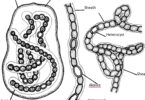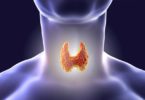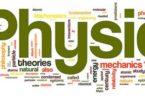The site of protein digestion is
(a) Gullet
(b) Stomach
(c) Small intestine
(d) Oral cavity
The most commonly used enzyme for polymerase chain reaction is
(a) D.N.A. polymerase-II
(b) Reverse transcriptase
(c) Klenow fragment
(d) Taq polymerase
Protein are diverse in nature because of
(a) Complexity of amino acids
(b) Different arrangement of amino acids
(c) Different molecular nature of amino acids
(d) Different molecular weight of amino acids
Which of the following is not correct about translation?
(a) It starts with AUG
(b) Stopped at termination codon
(c) Based on operon model
(d) Occurs in nucleus
Related: MCQ on Phylum Porifera
Which of the following proteins acts as a hormone ?
(a) Trypsin
(b) Keratin
(c) Oxytocin
(d) Casein
Portion of gene which is transcribed but not translated is
(a) Exon
(b) Intron
(c) Cistron
(d) Codon
The proteins which are insoluble in water are
(a) Fibrous proteins
(b) Globular proteins
During protein denaturation which of the following is disrupted
(a) 2D structure
(b) 3D structure
(c) Peptide bond
(d) AA sequence
Related: MCQs on Cancer
Irreversible precipitation of proteins is called
(a) Denaturation
(b) Hydrolysis
(c) Rearrangement
(d) Electrophoresis
DNA is not directly involved with the synthesis of the following
(a) m-RNA
(b) r-RNA
(c) t-RNA
(d) Protein
Which of the following proteins stores oxygen in the muscles ?
(a) Pepsin
(b) Collagen
(c) Myoglobin
(d) Actin
Which one process is only concerned with the transcription?
(a) Template binding
(b) Chain initiation
(c) Chain elongation
(d) Chain termination
Related: Photometry Questions
The proteins with a prosthetic group are called
(a) Pseudo proteins
(b) Complex proteins
(c) Conjugated proteins
(d) Polypeptides
Initiation of polypeptide chain in eukaryotic protein synthesis is induced by
(a) Methionine
(b) Leucine
(c) Lysine
(d) Glycine
Proteins are hydrolysed by enzymes into
(a) Dicarboxylic acids
(b) Amino acids
(c) Hydroxy acids
(d) Aromatic acids
Related: Snake Quiz for Kids
Who proposed the ‘Signal hypothesis’ meant for the biosynthesis of secretory type of proteins?
(a) Baltimore
(b) Camillio Golgi
(c) Blobel and Sabatini
(d) Sheeler and Bianchi
Which of the following bonds determines the secondary structure of proteins ?
(a) Electrovalent bond
(b) Covalent bond
(c) Hydrogen bond
(d) Coordinate bond
Who discovered “Reverse transcription”?
(a) Watson and Crick
(b) Temin and Baltimore
(c) Beadle and tatum
(d) Khorana
Proteins when heated with conc. HNO3 gives a yellow color. This is
(a) Oxidising test
(b) Xanthoprotic test
(c) Hoppe’s test
(d) Acid-base test
Related: Motion in One Direction Questions
After a mutation at a genetic locus, the character of an organism changes due to the change in
(a) Protein synthesis pattern
(b) RNA transcription pattern
(c) Protein structure
(d) DNA replication
In which of the following proteins are absent
(a) Pancreatic juice
(b) Saliva
(c) Bile
(d) Intestinal juice
Who first suggested the idea of circular flow of genetic information?
(a) Barry Commoner
(b) Nirenberg
(c) Matthaei
(d) Phil Lader
Which of the following bonds is responsible for the coiled structure of proteins ?
(a) Dipeptide bond
(b) Peptide bond
(c) Hydrogen bond
(d) Ionic bond
Related: Questions about Plants with Answers
The genes are responsible for growth and differentiation in an organism through regulation of
(a) Translocation
(b) Transformation
(c) Transduction and translation
(d) Translation and transcription
Trypsin is a digestive enzyme which occurs in mammals and digests
(a) Starch in buccal cavity in an alkaline medium
(b) Protein in stomach in an acidic medium
(c) Protein in duodenum in an acidic medium
(d) Protein in duodenum in an alkaline medium
A polypeptide is produced as dictated by mRNA, the number of bases on the mRNA that code for the polypeptide portion containing N–terminal amino acid and next 13 amino acid is
(a) 26
(b) 36
(c) 42
(d) 39
The exact sequence of events during digestion of protein is
(a) Proteins -> peptones -> acid metaproteins and peptides
(b) Proteins -> proteoses and peptones -> peptides -> amino acids
(c) Proteins -> acid metaproteins -> proteoses -> amino acids -> peptides
(d) Proteins -> primary proteins -> peptides -> amino acids
Related: Yeast MCQ
‘Central Dogma’ was proposed by
(a) Crick
(b) Beadle and Tatum
(c) Temin and Baltimore
(d) Klug
Protein is not present in :
(a) Nail
(b) Hair
(c) Wool
(d) DNA
Transcription is a process by which
(a) Amino acids are joined to form polypeptides
(b) An RNA molecule is synthesized on a DNA template
(c) An RNA molecule is synthesized within a ribosome
(d) Two daughter strands of DNA are synthesized
Which one of the following enzymes initiates protein digestion
(a) Aminopeptidase
(b) Carboxypeptidase
(c) Trypsin
(d) Pepsin
Related: Friction related Questions
Which of the following step of translation does not consume a high energy phosphate bond?
(a) Translocation
(b) Amino acid activation
(c) Peptidyl transferase reaction
(d) Aminoacyl tRNA binding to A–site
The smallest structural units of proteins are called
(a) Amino acids
(b) Peptides
(c) Proteoses
(d) Peptones
RNA which carry amino acid from the cytoplasm to the ribosome is
(a) m-RNA
(b) t-RNA
(c) r-RNA
(d) c-RNA
Which of the following part of the cell is the centre of protein synthesis?
(a) Plasma membrane
(b) Golgi bodies
(c) Ribosome
(d) Lysosome
Related: Questions on Liver Anatomy
The process by which DNA of nucleus passes genetic information to mRNA
(a) Translocation
(b) Transcription
(c) Translation
(d) Transportation
Proteins are built up of
(a) Dicarboxylic acids
(b) Amino acids
(c) Alcohols
(d) Hydroxy acids
If a certain group of cells utilise the amino acid glycine exclusively for protein synthesis, and if a growing culture of these cells is fed radioactive glycine, radioactivity will be found first in the
(a) tRNA
(b) Ribosomes
(c) mRNA
(d) Mitochondria
Which level of protein structure is affected by DNA?
(a) Primary structure
(b) Secondary structure
(c) Tertiary structure
(d) Quaternary structure
Related: Questions about Bacteria
What is meant by monocistronic mRNA?
(a) Which has only one codon
(b) Which has codons for synthesizing only one protein molecule
(c) Which can combine with only one type of tRNA






